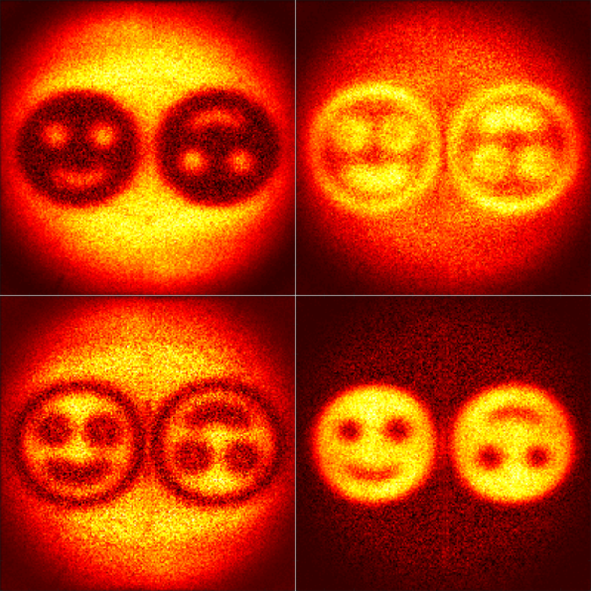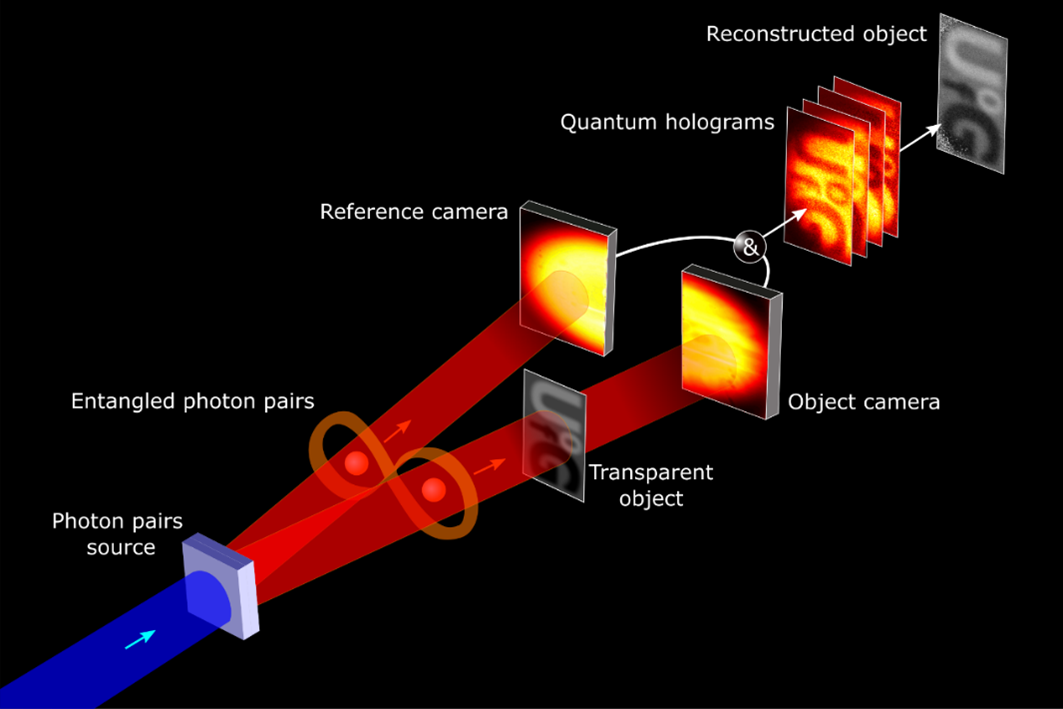Resources
 Part of the Oxford Instruments Group
Part of the Oxford Instruments Group
Expand
Collapse
 Part of the Oxford Instruments Group
Part of the Oxford Instruments Group
Holography is the process of recording an optical wave that is diffracted or scattered by an object. This process enables to subsequently restore a three-dimensional image of the object. Holograms – the products of holography - are familiar to us as they are printed on all our bank notes, credit cards and passports. But holography has also many other practical applications, including biological microscopy, medical imaging, and data storage.
Holography is based on a fundamental property of light called ‘coherence’ that allows optical waves to interfere with each other. Optical coherence is vital to any holographic protocol. Researchers from the University of Glasgow led by Dr Hugo Defienne and Dr Daniele Faccio developed a new approach that circumvents the need for coherence in holography by exploiting quantum entanglement between light particles [1].
Holography was invented in the early 1950s by the Hungarian-British physicist Dennis Gabor (1900–1979) [2]. He reported the discovery for the first time in 1948 in a Nature publication entitled ‘A new microscopic principle’ [3], for which he later received the Nobel Prize in Physics (1971). Until the 1980s, holograms were primarily a scientific curiosity. Then, thanks to the rapid development of lasers, they gradually took an essential place in our society, from the security of credit cards and bank notes to the surrealist paintings of Salvador Dali, passing by science-fiction movies.
More importantly, holography has become an essential tool for biological applications and medical diagnosis. In a technique called holographic microscopy, scientists make holograms to characterize in detail biological tissues and living cells. For example, this technique is routinely used to analyse red blood cells [4] to detect the presence of Malaria parasites and to characterise sperm cells [5] for in-vitro fertilization processes.
Despite the diversity of their applications, holographic methods all have one thing in common: the light used must be coherent. Indeed, optical coherence is a property that allows light to interfere, a process that is central to the production of holograms. For example, the light emitted by a laser is nearly perfectly coherent, and therefore this type of light is used in most holographic systems. However, the light produced by the Sun, or a white LED, is incoherent and therefore cannot be used as such for holography.

Figure 1: Quantum holograms of a smiley-shaped phase object, as of [1]
Optical coherence is vital to any holographic process. However, a new study by Dr Defienne and collaborators circumvents the need for coherence in holography by exploiting quantum entanglement between photons [1].
Holography fundamentally relies on optical coherence because (i) light must interfere to produce holograms and (ii) light must be coherent to interfere. However, the second part in this argument is not entirely true because there are certain types of light that can be both incoherent and produce interference-like phenomena. This is the case for light made of entangled photons, emitted by a quantum source in the form of a flow of particles grouped in pairs.
These pairs carry a unique property called quantum entanglement. When two particles are entangled, they are intrinsically connected and effectively act as a single object, even though they may be separated in space. As a result, any measurement performed on one entangled particle affects the entangled system as a whole.
In the Glasgow’s system (see Figure 2), one photon of a pair is sent towards an object while its twin propagates in free-space. As it passes through certain parts of the object, a photon will slightly slow down depending on the thickness and optical properties of the material. A projected image of the object is thus imprinted in the photon flux, or equivalently in the optical wave associated with it. Because the photons are entangled, the projection imprinted on one photon is simultaneously shared by both. The interference phenomenon then occurs remotely, without the need to overlap the beams, and a hologram is finally obtained by measuring correlations between the entangled photon positions using two separate parts of an Andor EMCCD camera.

Figure 2: Schematic of the experiment [1].
Measuring correlations between entangled photons to retrieve quantum holograms is a key technical aspect in this experiment. Thanks to the high quantum efficiency, single-photon sensitivity, and low noise level of the Andor EMCCD camera (model Ixon Ultra 897), the Glasgow team was able to detect photon coincidences between more than 1 billion pairs of pixels in parallel, enabling the reconstruction of high-resolution 40k-pixels quantum images. Performing this experiment would have been impossible using other photon coincidence counting technologies, such as raster-scanning techniques or current commercial single-photon avalanche diode arrays. The use of Andor EMCCD cameras for photon-pair-based quantum imaging is part of a long line of research in the Glasgow team, at the basis of other recent research works such as quantum image distillation [7] and pixel super-resolution [8].
The most impressive aspect of this quantum holographic approach is that the interference phenomenon occurs even though the photons never interact with each other and can be separated by any distance – an aspect that is called ‘non-locality’. For example, the object measured by the Glasgow team and the final measurements could be performed at opposite sides of the planet.
Beyond this fundamental interest, the use of entanglement instead of optical coherence in a holographic system provides practical advantages such as better stability and noise resilience, as well as higher spatial resolution. These advantages could help resolve finer details of biological tissues and potentially reveal cellular processes that cannot be observed with current microscopy techniques.
Dr Hugo Defienne, May 2021
